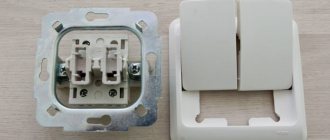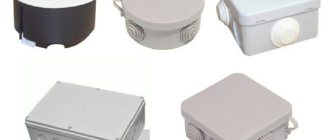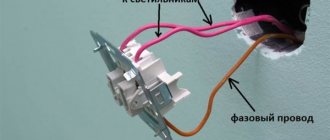Device and principle of operation
The sound sensor for automatically turning on the light is a microcircuit whose main components are an audio receiver, an amplifier, an electric relay and a controller. The device operates according to the following principle:
- In the room where the sound detector is installed, a sound is heard (footsteps, voice, clapping).
- The audio receiver records the acoustic wave.
- The resulting signal passes through the analyzer.
- Next, a command is sent to close the electric relay.
- Electric current begins to flow to the light bulb - the light turns on.
- At the same time, a timer is connected to open the circuit (depending on the settings specified by the user - from several seconds to tens of minutes).
- While the light is on, the sound sensor is actually turned off and does not in any way affect the operation of the backlight system.
Modern detectors of this type are quite sensitive. Therefore, in order to exclude false alarms in a specific application location, it is necessary to perform the correct settings for this parameter.
For this purpose, there are two regulators on the body of the device. One of them sets the threshold of perceived sound. The other programs the operating time of the lamp after switching on. As a rule, a limit of 50 dB (equivalent to clapping your hands) is sufficient indoors.
Read with this
- Alarm with motion sensor for room security
- Inductive sensors, position sensors
- Lighting control: motion sensor and presence sensor
- How to choose the right light sensor, description and classification
- Illuminance unit
- How to install a motion sensor to turn on the lights
- Xiaomi smart home components and devices
- How to choose a DVR with motion sensor and night vision?
- Staircase lighting in a private house: 35 photos
- Selection and use of carbon monoxide and smoke detectors
Settings
The product is adjusted using two variable resistors. The goal is to achieve such a level of sensitivity that the switch does not trip when loud music, voices, or extraneous noise occur. When installing, the microphone should be pointed in the direction where the clap sound comes from.
Why is hand clapping used as a signal? When struck with the palms, a high-amplitude sound wave is generated, which is well captured by the microphone. Due to the high amplitude of the control signal, the possibility of unauthorized operation is eliminated. When used in a microcontroller circuit, you can replace the command that controls the light from clap to any sound or word. You will find all the nuances of installing a cotton switch in a separate material.
The finished product is shown in picture 1.
Using a certain word as a command causes difficulties, since it has to be pronounced with a certain intonation to obtain the desired amplitude.
In any house or apartment there are devices that are responsible for lighting - these are switches. The simple ones are keyboards, and the more complex ones can be different - touch, backlit, LED, pass-through, infrared. You can learn about all these types, as well as how they are repaired in case of breakdown, installed or replaced, in separate articles on our website.
With the knowledge gained, you will be able to make this device, which will be useful on the farm.
Video – acoustic relay
Tests have shown that sometimes there are still false alarms, but only from sharp short sounds. The TV nearby is quite loud, but I didn’t notice any triggering from it. The design from the radio cat was assembled and repeated by iveko
.
Discuss the article LIGHT SWITCH BY COTTON
Nowadays, remote control of lighting is becoming popular. You can use a sound or clap switch for this. If the sound is intense enough, equal in strength to clapping your hands, the light turns on or off. If earlier such electrical circuits were assembled by radio amateurs, now the device can be bought in many electrical goods stores.
Cotton switch model
Application: relevance
A cotton switch is indispensable in cluttered (with poor natural light) rooms where it is difficult to get to or find electrical fittings on the wall.
Sound devices are especially in demand when organizing lighting/equipping electrical control systems for various storage facilities, warehouses and utility rooms.
Acoustic switches in residential areas
Sound devices are installed in the basements of buildings, vestibules and storage rooms of private houses/apartments. The remote control is useful in a children's room: in order to turn off the lights, children no longer need to move a chair or ask their parents for help. A cotton switch is indispensable for people with disabilities: there will be no need to resort to the services of relatives.
Interfloor space lighting
In the entrance (on the landing) of a house, it is justified to install an acoustic module with the lights turned off after a configurable period of time. The option is implemented by integrating an additional node into the circuit: a chain with a time delay on the chip (timer).
The device responds to the sound signal produced by residents and visitors to the house: the creaking of an opening door, clapping of hands, conversation and footsteps. After triggering, the lighting of the interfloor space is turned on, for example, for 5 minutes. This time is enough to open or ring the doorbell. In case of time pressure, an additional clap will update the time delay.
Principle of operation
A primitive model of an acoustic device that can be assembled by hanging installation with a test light and an 8-volt power source. The following are used:
- powerful direct bipolar transistor type KT818, or foreign analogues,
- push-pull microphone amplifier,
- a regular microphone (for example, from a tape recorder or headphones)
Such an acoustic switch device allows you to clearly trace the mechanism of converting a noise signal into an electrical one. The microphone receives the wave signal and transmits it to the amplifiers, after which a transistor is triggered through the base of the switch, starting the current connection.
Automatic soft switch
The switch serves to smoothly turn on the light from an analog microphone signal for a specified time.
Scheme of operation of a smooth acoustic switch
The sound enters the microphone, is converted into an electrical signal and amplified, passing through the operational amplifier (DA1.1), charging the capacitor (C6). When the charge becomes greater than the capacitance (C7), the comparator (DA1.2) switches, and a logical one signal appears at its output instead of zero. As a result, the generator on the transistor (VT1) starts, it supplies pulses that open the triac (VS1), through which power is supplied to the lamp (EL1).
After a certain time, the voltage across the capacitor will decrease. As it decreases, the triac receives control pulses with an increasing phase delay, causing the lamp to turn off smoothly.
Having selected the ratings (C6) and (R5), you can turn on the lamp for up to 3 minutes.
Advantages of cotton switch
The high-tech filling of the device closes and opens galvanic circuits from the generated sound pulse, including clapping of hands. This control method can cover not only all home light sources, but also most household appliances that are powered by electricity: stereo systems, climate control equipment, television equipment, and illumination of florariums.
The product will significantly save time for its owner, acting as a full replacement or duplicate of a conventional remote control/switch. Any electrical consumers that fall within the acoustic reception range of the device can be used in tandem with it.
Transistor packaging products
The cased cotton transistor light switch is placed in a plastic box, protected from water and dust. Transistor-type switches enclosed in a housing are successfully installed in a network with a weak current source, for example, in a video surveillance system.
The body dimensions of such a product are no larger than a matchbox. However, it contains high-tech filling, which includes a printed circuit board with SMD components, an electronic relay and a piezoelectric sensor.
Open-frame devices
When you need to integrate a switch inside a household electrical appliance, it is advisable to use a model without a housing.
The printed circuit board, where the components of the product with the acoustic sensor are fixed, is fixed under the air conditioner housing or inside the fan leg. This type of acoustic switch assembly is more compact and costs much less than the case version.
Plug-socket type product
Removable models of electrical installation products in a housing made of synthetic polymers can be equipped with a power plug and one to three output sockets. They are intended for floor or wall lamps, household appliances, music centers, gadgets, and various energy-consuming devices. In this case, the acoustic switch acts as an adapter from a current source from a 220 V network to a load equipped with a board that controls sound.
No complex electrical installations are required. The unit with the acoustic sensor will begin to work after the simplest docking of the switch of the “plug-socket” type.
There is nothing complicated about equipping stationary room sockets with the required number of switches to interface with lighting and household appliances or a group of consumers with “doubles” and “tees” at the output.
The operating diagram of a 220V cotton switch will look like this:
- switch No. 1 will connect/disconnect the socket with three claps,
- No. 2 will react from four;
- No. 3 is controlled by six clap strokes;
- No. 4 will work after five claps.
The acoustic module integrated into the “plug-socket” operates against claps using a selective filtering method that distinguishes characteristic sounds from other noise.
Turning off the light with a clap: benefits and advantages
The high-tech device closes and opens an electrical circuit when a sound signal is given, such as clapping your hands. It is capable of remotely controlling not only the lights in the house, but also other electrical appliances: a fan, a humidifier, a stereo system, equipment, and aquarium lighting.
This useful device replaces or duplicates the traditional switch/remote control, saving users time on actions. All electrical consumers located in the acoustic sensitivity zone of the device can be equipped with acoustic switches.
In a transistor housing
The switch in a transistor housing is placed in a plastic box with a degree of protection from dust and moisture ≥ IP30.
Thanks to the use of printed circuit boards with an SMD element base, a piezoelectric sensor and a solid-state relay, the dimensions of a modern acoustic switch in a transistor housing do not exceed the dimensions of a matchbox.
Transistor devices are successfully localized in low-current networks (alarms, video surveillance, etc.).
Without housing
The use of a product without a housing is justified if the user intends to integrate the product into the housing of some electrical appliance. For example, it involves fixing a printed circuit board with components and an acoustic sensor under the air conditioner casing or in a fan stand. An open assembly is more compact and noticeably cheaper than a device in a case.
Switches and lamps "plug-socket"
A plug-socket switch is a removable electrical installation product in a plastic case with an input plug for connection to the network. The product is equipped with 1-3 output sockets for connecting floor lamps, sconces, complex household appliances, equipment, gadgets and other energy consumers. The product is an adapter for the path of electric current from a 220 V network to the load, equipped with a sound control board.
The usual docking of a plug-socket switch allows you to connect a module with an acoustic sensor without electrical installation work.
It’s very easy to insert 1–4 switches into the room’s fixed sockets and configure them for different consumers (or groups of consumers for devices with “double” or “tee” type outputs). For example, the 1st switch will connect and disconnect the power socket with 3 claps, the 2nd will operate with 4 claps, the 3rd will respond with 5 claps, the 4th will control 6 clapping hands.
The acoustic switch built into the “plug-socket” is triggered by clapping your hands thanks to selective filtering, highlighting characteristic sounds from background noise.
This is interesting: Pipes for electrical wiring - PVC, HDPE, metal (steel, copper, galvanized), plastic, soft and hard
Principle of operation
The device operates using a microcontroller installed in it. The controller authorizes turning the light on and off by clapping. If desired, this device can be used to control other electrical household devices (air conditioners, fans, etc.).
The sound from the clap passes through the microphone, where the electrical impulse is amplified and transformed. Next, the sound is equalized due to the work of rectifying diodes. The sound is controlled by a resistor (if the sound volume level is below the specified level, the resistor will prevent the device from operating).
The light turns off and on after sequential charging and discharging of the capacitors. At the end of a full cycle of activity (one more bang), the resistor and capacitor C10 are discharged in four seconds. This causes the device to turn off.
Light switches that are activated by clapping sounds can be found commercially or you can make your own. Let's consider the device "Ekosvet-X-200-L", produced by the Belarusian company. It has the following technical characteristics:
- load power - up to 300 watts;
- sound intensity - 30–150 decibels;
- mains voltage - 220 volts.
Cotton switches "Ekosvet-X-300-L" are designed to turn lighting on and off using a loud and ringing sound. In addition to the switch itself, the kit includes a box and installation instructions.
The price of this switch in comparison with similar devices from other manufacturers is quite affordable. The switch is produced in a protective housing class IP-30. It can operate at temperatures from -20 °C to 40 °C. READ MORE: Core drilling technology and nuances of work
This device can be combined with virtually any lamps: halogen, fluorescent, energy-saving, LED and standard incandescent lamps. The device is no larger than a matchbox, so it can be easily placed at the base of any light source. The switch is attached using double-sided construction tape or self-tapping screws.
Copper wires can be connected using Wago terminals
Advantages of Wago terminal blocks:
- speed, accuracy and ease of connecting wires;
- electrical safety;
- no need to use special electrician tools;
- reliability;
- aesthetics and beauty.
Disadvantages of Wago terminal blocks:
- high price;
- The location of the nest is not very convenient.
An optical-acoustic switch is used for dimmer switching on electricity. It works as follows:
- The sound signal (in our case it is a clap) arrives at the sensitive membrane of the microphone. There the sound is converted into an electrical impulse. When passing through the operational amplifier, the pulse power increases and the capacitor is charged. When the charge reaches a higher value than on the capacitance, the comparator switches. In this case, the zero at the output is replaced by a pulse from the logical section.
- Such a chain is sequentially activated in the switch after receiving an acoustic signal from the microphone. Then the transistor generator is started, directing the electrical impulses, and the triac opens. Through it, power is supplied to the light source.
- After some time, the capacitor loses voltage level. In this case, the triac receives control electrical signals with an ever-increasing phase delay, as a result of which the light turns off smoothly. With optimal selection of values, the light source turns off with a pause of up to three minutes.
An optical-acoustic switch is used to switch on electricity by dimmer
DIY cotton switch.
| COOL ACOUSTIC light SWITCH with your own hands |
| Click to view | You can easily assemble an acoustic light switch with your own hands from very common radio components... |
| Tags: |
| How to control LIGHT. Simple COTTON SWITCH |
| Click to view | Help the Channel - -Kiwi Card 4693 9575 5666 5821 -Webmoney: ... |
| Tags: |
| "Cotton Switch" |
| Click to view | Our sites Official group of the channel Group ... |
| Tags: |
| HOW TO MAKE A SIMPLE COTTON SWITCH |
| Click to view | Channel Straight Hands: . Material for video on the site: ... |
| Tags: |
| Acoustic cotton switch. DIY COTTON SWITCH! |
| Click to view | Cotton switch WITH YOUR OWN HANDS!!! ACCORDING TO THE SCHEME. HOW TO MAKE A SIMPLE COTTON SWITCH. |
| Tags: |
| SOUND SENSOR – Microdynamic switch |
| Click to view | How to make a touch... |
| Tags: |
| Acoustic switch |
| Click to view | The circuit allows me to control the load using sound, for example, you can arrange a cotton switch... |
| Tags: |
| Acoustic relay with 3 transistors!!! With my own hands. |
| Click to view | Group on VK. Subscribe. Friends, here is a small selection of products from Aliexpress. |
| Tags: |
| "Cotton Switch" |
| Click to view | See how easy it is to connect an acoustic (sound, cotton) to a lamp (chandelier, lamp). .. |
| Tags: |
| Acoustic switch “SONIC PRO” (one or two claps) - connection to a lamp, chandelier, etc. |
| Click to view | Optical-acoustic energy saving switch VA-11, review after 2 years of operation. Also on the channel... |
| Tags: |
| Acoustic switch after 2 years |
| Click to view | VK group: INSTAGRAM - Support channel: 4038 ... |
| Tags: |
| The Simplest Acoustic Switch - "Clap Switch" - How To Make A Clap Switch |
| Click to view | Simple acoustic light switch. I got it here - Other interesting DIY kits... |
| Tags: |
| DIY KIT. Do it yourself. Simple acoustic light switch. |
| Click to view | In this lesson we will analyze a sketch for a cotton switch. Link to Sound Sensor: Link... |
| Tags: |
| Acoustic switch |
| Click to view | Have you heard about cotton switches? These are devices that... |
| Tags: |
| Lesson 13. Cotton switch from Arduino |
| Click to view | Acoustic (clap) light switch on PIC12F629. Having a number of functional settings. |
| Tags: |
| Clap switch or turning on the light by clapping. Operating principle, connection diagram |
| Click to view | All the necessary parts for this circuit are here: Components for repairing or creating acoustics - ... |
| Tags: |
| Acoustic light switch based on PIC12F629 microcontroller. |
| Click to view | The simplest acoustic switch, even for a beginner radio amateur, it can be made without haste... |
| Tags: |
| DIY - Acoustic Switch |
| Click to view | The video shows how to #assemble an acoustic signal with your own hands #turn it off. That is, I switch... |
| Tags: |
| The simplest acoustic switch" rel="spf-prefetch |
| Click to view | Description missing |
| Tags: |
| Do-it-yourself acoustic (cotton) switch.” rel=»spf-prefetch |
Types of Sound Light Switches
DIY touch switch
A sound switch is a small, sensitive microphone that is configured to turn lights on or off when it senses sound vibrations. Now there are the following types of these devices:
- Direct switch off sensor. The developers have established a precise signal by which this switch turns on the lighting and performs the opposite action at the next sound. Such a device is mainly attached in parallel with the switch. And when a simple switch is used, the sensor will not operate;
- Sensor in combination with a timer or light sensor. Thanks to this device, the light comes on for a certain period of time, and at high levels of illumination it does not work at all. The presented inexpensive acoustic light switches are now in great demand on elevator platforms and in the entrances of multi-apartment residential buildings;
- Sensor equipped with intelligent control. It can be considered a mini-computer, easily customizable to the user's wishes. Thanks to this equipment, it is possible to easily control several audio devices at once;
- Clap switch for low-current systems (for example, alarms and video surveillance). Here, the lights may not even be turned on, but the sensor, tuned to changes in sound in the building, in the established mode is capable of starting video recording of observations from the recorder or transmitting the received images to the owner.
The advantage of the listed types of devices is additional functions along with lighting control. With this sensor, we not only turn on the lights conveniently, but also save energy.
Such switches also have disadvantages:
- sound selectivity (it is not always possible to produce exactly the sound that is necessary to start working);
- sensitivity zone (in a large room you will have to clap louder or move closer to the sensor).
Switches for home (domestic use)
Various types of switches are used in everyday life, but their purpose is usually limited to controlling lamps. Such a switch should be convenient, safe, and have an attractive design. According to the installation method, it can be built-in or installed externally. Nowadays, rotary keys are used as controls; such switches are common in Europe.
In the USA, almost all switches are lever-type (toggle switches), apparently, a tradition. Even earlier, rotary switches were used, an invention of Thomas Edison. They were common throughout the world in the first half of the 20th century and switched up to several circuits in 3–4 positions (batch switch). Package switches are still used in many old utility panels.
To turn on lamps, a single-key switch is used; for chandeliers, a two-key switch or even a three-key switch is used. A double light switch is also often used for a toilet/bathroom pair. It must be said that modern light sources are very advanced compared to what they were 15 years ago. Therefore, many switches with additional functions have appeared. The simplest of them is a backlit switch for night time.
A switch with a shutdown timer is used to save light in small rooms (closets, bathrooms) where people enter for a short time and forget to turn off the lights.
The switch with a dimmer can be used with those luminaires that support the dimmer function. Sometimes they are included in the kit, since this type of device has not yet been standardized.
A light switch with a motion sensor is another way to save electricity and is very convenient. The light turns on if the infrared sensor detects human movement within the sensor's field of view. Repeated motion may turn off the lights, or a timer may do so after motion has been detected. A switch with a motion sensor does not require any action from a person; his presence is sufficient.
There is a rather exotic type - a cotton switch. Inside it there is a microphone, an amplifier and a microprocessor device for recognizing the nature of the sound. Such a switch, after installation, may not work the first time, since it stores the sound from the user in memory for later comparison. I must say frankly that this is a rather stupid way to turn the light on and off - people may already be asleep and the noise will disturb them.
The floor switch is made in the form of a button with a locking mechanism. It is designed for a small pressing force and is structurally designed in such a way that it is not damaged by large weights and can withstand the weight of the leg.
The ceiling switch is also a button with a lock, to which the force is transmitted from a lever with a cord attached to it. The mechanics are hidden behind a decorative cover. To use such a switch, turn it on or off, you need to pull the cord or tug it lightly.
Manufacturers
The most famous models presented on the Russian market are “Ecosvet” and “Claps”. Let's look at their main characteristics.
Switch "Сlaps"
One of the newest developments is the “Claps” cotton switch model. In this device, the sound is processed using a microprocessor; it does not react to any extraneous noise, but is tuned to several claps in a row (this is the most important operating condition).
It is permissible to install several such switches in one room, each of them will react to a certain number of claps, and accordingly turn on the light, humidifier, fan, TV or stereo system. This switch model is suitable for any household appliances that have an electrical cord.
Perhaps to some, the clap switch may seem like a toy or a completely unnecessary device. Others, on the contrary, are passionate about the idea of creating their own “smart home” so that lights and electrical appliances turn on and start working on command or clap. Arrange your life the way you want, but at the same time make it as comfortable as possible.
Ecolight switch
The Ecosvet device is designed to work with 220 Volt light bulbs.
Main parameters of the device:
- load - 300 Watt;
- sound signal spread - from 30 to 150 decibels;
- housing protection level - IP30;
- permissible temperature range - from 20 degrees below zero to 40 degrees above zero;
- cost - from 350 rubles.
“Ekosvet” is fixed with self-tapping screws using the mounting legs. It is not recommended to install the device in noisy rooms. Despite the fact that “Ekosvet” is configured to clap, false alarms are possible.
The figure above shows the device connection diagram. "Ecolight" is connected to a conventional switch to provide the ability to de-energize the circuit and stop its operation.
Criterias of choice
Before you acquire such a device, you need to determine for what purposes it is needed. On the staircase, in the courtyard and entrance, you can install the most common acoustic sensor that responds to any noise from the surrounding area. This option will allow a person climbing stairs or crossing a darkened area to reach their destination without fear of a blackout. If you install a relay that turns off after a certain period of time, an elderly or slow-walking person will find himself in the dark. The shutdown delay can be adjusted if it is provided by the manufacturer, or design changes can be made to an already purchased device.
There are other requirements for devices of a certain type:
- the street sensor must be reliably strengthened and equipped with protection from natural influences (this is especially important in regions with problematic climates;
- if the purpose of the purchase is to save lighting, it is better to purchase a model equipped with a photo relay
- the principle of operation of a dimmer acoustic switch is useful in a personal plot, in a country house - the lighting will turn off as soon as the external space no longer needs additional light, but it is also useful where people leave the room for a short time and return again (in the kitchen, in the production workshop ;
- the range of action is important if you plan to control a large space; for apartment conditions, the minimum indicators are sufficient.
Sometimes in reviews of such products you can find insistent assurances about the need to purchase sensors from a branded manufacturer with a proven reputation and high cost. At home, you can perfectly use homemade sensors that you assemble yourself. If you have no knowledge on this issue, you can simply buy a reliable domestic device.
How does an acoustic switch work?
A microphone or acoustic sensor converts sound vibrations into an electrical signal. After the audio frequency amplifier, the AF signal is detected, and a constant voltage is supplied to the base of the transistor switch, the load of which includes the relay winding. After exceeding the threshold level on the base, the key is activated and the relay closes the 220 V power contacts of the electrical receiver. When the sound command is repeated, the circuit automatically turns off and the current flow in the lamp or electrical appliance stops.
Specifications
Typical technical characteristics of an acoustic device for use in a residential building:
- net weight (without packaging) 30 – 60 g;
- overall dimensions 40*40*15 –86 *86 *26 mm;
- household voltage 220 V;
- maximum load current 5A;
- load power 200–1100 W;
- sound sensitivity adjustment 20–150 dB;
- housing protection class IP30 – IP34;
- relative humidity from 20% to 60%;
- operating temperature from 0°C to +40°C;
- Product warranty period is 12–24 months.
Components
A standard acoustic switch consists of the following parts, soldered on a printed circuit board:
- transistors and diodes;
- diode bridge and zener diode;
- trigger and comparator microcircuits;
- resistors and capacitors;
- microphone and relay.
The board fits into a sturdy plastic case with latches.
Differences between clap and sound (voice) switch
Voice control devices are more complex than slam switches. They use special active filters on microcircuits that perform the functions of a command decoder. They recognize a sequence of vowel sounds of a certain frequency and duration, ignoring acoustic interference.
Installation and connection diagram of a cotton light switch
As I said above, I plan to install a cotton switch in my bedroom. I have a lamp installed there with two CFL lamps.
At the moment, the lamp is connected via a single-key switch. The diagram looks like this:
Here is a diagram for connecting the Ecosvet-X-300-L remote switch, which responds to claps.
The white wires need to be connected to a 220 (V) network, and strict polarity is not required. A load is connected to the black wires - in my case, two CFL lamps.
Currently, phase (via a single-key switch) and zero are supplied to the lamp from the distribution box. These are the ones we need to connect to the white wires.
The black wires must be connected directly to the lamps of the lamp, which are connected in parallel with each other.
Here is the power supply diagram for a lamp with a cotton switch:
The clap switch is powered through the existing single key switch. If we want to temporarily disable it, then just turn off this single-key switch.
Using the sound sensitivity control, we set the level we need.
Let's adjust the regulator so that the clap is not weak (to eliminate false positives from light random clapping) and not strong (so as not to knock off your hands).
Tests and experiments (video)
Let's check this switch for the following extraneous loud and ringing sounds from:
- hammer blows
- working vacuum cleaner
- phone ringing
- hammer drill operation
- knocking of dishes (mug with spoon)
Let's try to provoke false alarms by exposing the switch to sounds from the above-mentioned instruments and devices. I filmed the operating algorithm of the switch, as well as the experiments I carried out:
Let us draw a conclusion from the experiments: the switch falsely reacts to sounds from the operation of a hammer drill and to very loud sounds from a spoon knocking on a mug. In other cases, no false positives were observed.
After an hour of work, I checked the heating of its case. I can please you - the case is slightly warm, which is safe from a fire standpoint.
How to assemble?
To make miracle technology yourself, you need the following skills and knowledge:
- on reading simple electrical circuits;
- experience with a soldering iron;
- ability to understand electrical and radio components;
- practice in the manufacture of printed circuit boards.
The switch will operate at 9 volts. A rectangular battery is suitable as a power source, but it can be replaced with a battery. When using a step-down transformer or DC-DC converter, you can operate from a 220 W network.
If you don't have the skills or qualifications, it's best not to try to do it yourself. For such people, there is a huge selection of ready-made options.
Parts List
Resistors:
- R1– 10K;
- R2– 1M;
- R3– 22K;
- R5– 2K;
- R6– 1.8K;
- R7– 330 Ohm;
- R8– 1.5K.
Transistors:
- VT1–KT315;
- VT2–RT315;
- V3– 3107 (DC557).
Capacitors:
- C1– 2200 pF;
- C2– 1 µF*10V.
Diode - VD1– 1N.
Miscellaneous:
- M1 - electrical chip;
- HL1 – LED or relay;
- contact block.
If a relay is used as a load, then resistor R8 must be changed to 2 Ohms.
Electrical diagram
There are many options on the Internet of varying complexity depending on the configuration, but not all of them are functional. Defects appear during manufacturing. The presented electrical circuit has been tested in practice.
Here VD1 is intended to protect transistor VT3. To use the relay, a diode must be installed. If you decide to install a light load, we recommend replacing the diode with a jumper.
Step-by-step instruction
The acoustic module itself is glued with tape from the inside to the chandelier or the body of an electrical appliance; connections are easier to make with Wago-type terminal blocks:
- de-energize the network, break the power circuit going to the key switch, remove the insulation and strip the ends of the wire;
- a pair of white wires from the acoustic module are connected to the phase and neutral coming from the shield or junction box;
- The two remaining black wires are similarly connected to the terminals of a lamp or household appliance.
All that remains is to move the button of the conventional switch to the “on” position, the system is ready for operation.
Acoustic switch circuit
There are a huge variety of acoustic switch (AS) circuits: on transistors, logic chips, flip-flops, etc., but we will assemble our device on a microcontroller. Using a microcontroller, you can quite simply implement algorithms of varying complexity with minimal circuit modification or no modification at all.
The first and integral element of any acoustic switch is a microphone. The microphone converts the audio frequency signal into alternating voltage. The simplest electret microphone will suit us.
One terminal of the microphone is connected to the negative, and the second, through a trimming resistor R1, with a resistance of 510 kOhm, to the positive. Using R1, you adjust the microphone sensitivity. Next, the alternating signal from the microphone output through a 1 µF capacitor C1 is fed to an amplifier made on a single BC547 transistor. The emitter of the transistor is connected to the minus, and the collector is connected to the plus through resistor R2, with a resistance of 1 kOhm. The amplifier is adjusted using a tuning resistor R3 with a resistance of 1 MOhm.
Next, the amplified signal is fed to the input of the ATmega8 microcontroller. Depending on the number of received pulses, which corresponds to the number of claps, the microcontroller outputs a high or low potential to the corresponding pins. In this circuit, we use three pins of the MK microcontroller, which operate as output. They feed three similar circuits. Let's consider the operation of one circuit.
When there is a high potential (+5 V) at the MK output, transistor VT2 of the 2N2222 series, connected to the MK by resistor R4 (1 kOhm), opens and relay coil K1 receives power. When relay K1 is triggered, its contacts close in the lamp power circuit and thus it lights up.
The relay coil K1 should be shunted with a reverse diode VD1 to protect against overvoltage, since the coil has some inductance, and if the circuit breaks, a voltage surge may occur, although not significant in this case, but it is better to be safe. Almost any diode with a current of at least 100 mA will do; you can use 1N4148.
Any relay can be used, but you should focus on the following parameters: supply voltage 5 V, voltage of the closing contacts - alternating, 230 V. The contact current is determined by the load of the circuit that the contacts will close and open. I used the following type of relay: HW32-005VDC-A. If you find a relay with a coil supply current of no more than 20 mA, then you can do without a transistor switch.
The acoustic switch circuit is powered from a stabilized power source with a voltage of 5 V. You can take any ready-made power supply or assemble it yourself, as described in this article.
Assembly option
The circuit of a simple acoustic switch with a power supply of 4.5-12 volts, and with an operating range at a distance of 2-3 m, is assembled on a printed circuit board or breadboard and consists of a larger number of parts.
Such devices are also called “clap” devices; their functional feature is sequential switching off and switching off with a sharp sound signal, similar to the clapping of palms.
The KT818 transistor connected to a relay with a 9-volt power coil is responsible for the power part.
The sensitivity of the electret microphone is set by a 10 kOhm power resistor and a 0.1 μF capacitor. It can be adjusted based on the resistance of the resistor and the capacitance of the capacitor, and through the use of more sensitive transistors. The resistor value can start from 2 kOhm, depending on the power supplied to the circuit.
Next are two amplification stages with bipolar transistors KT315 (you can use imported analogues, for example 2N5551). Resistance values can be varied by 50%. For an electromagnetic relay, you need to install a protective diode. Silicon 1N4148 or 1N401 is suitable for this function. To indicate the operation of the circuit, an LED can be installed in the power section.
Socket device with switch
There are units on sale in which power and lighting switches are combined. Structurally, they do not differ from separate devices, except that they have 1 common contact for the phase.
Advantages
The combined electric point has a number of advantages:
- Simple connection diagram, because both devices are powered by 1 line.
- Wire saving.
- The need to knock out 1 hole in the wall instead of 2 and with large dimensions, which makes the process easier.
Flaws
The negative sides are:
- High cost: individual electrical installation products are cheaper than a combined device.
- The need to change the entire device if one of the modules breaks down.
- Limited choice of installation location: such products are used in corridors or technical rooms - garages, etc.
- Increased load on the wire.
The installation of a socket with a switch is very expensive.
Scope of application
The feasibility of installing an acoustic device has long been appreciated both in the domestic aspect and on an industrial scale. One of the arguments in favor of sound sensors is extending the life of light sources, which, unlike simple incandescent lamps, are not inexpensive. Installing a simple or home-made device is cheaper than replacing burnt out light bulbs, paying for electricity by meter, and the cost of over-consumption.
You can use sound sensors:
- in distant rooms (rooms, storage rooms, warehouses, closed verandas), where people do not enter often, especially in winter;
- in functional rooms of medical buildings or production, where the switch is not used due to dirty hands or safety reasons;
- in passages (gateways, corridors of public buildings - offices, business centers, government agencies;
- in garages, operating rooms, and other rooms where installing a standard switch is in principle impossible.
Turning on the light by clap in living rooms, toilets, bathrooms and kitchens is not very popular. Much more often it is used in the corridor, where the lights are turned off after a person has undressed and gone to another place. For example, when a person is sitting on the toilet, he can be in a calm state, and then the device, without picking up noise from movement, will automatically turn off the lighting.











